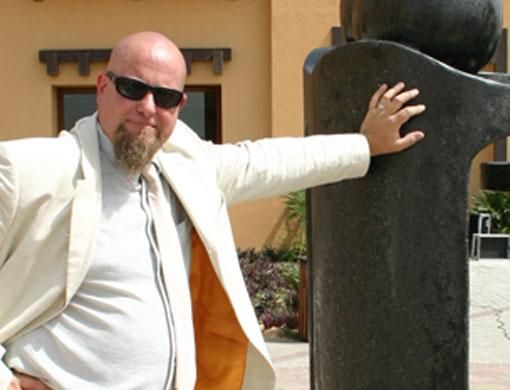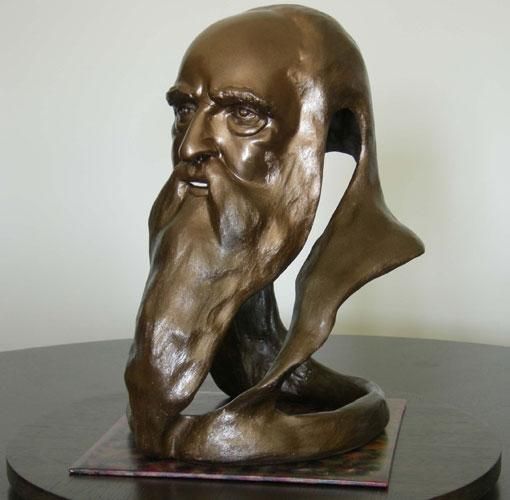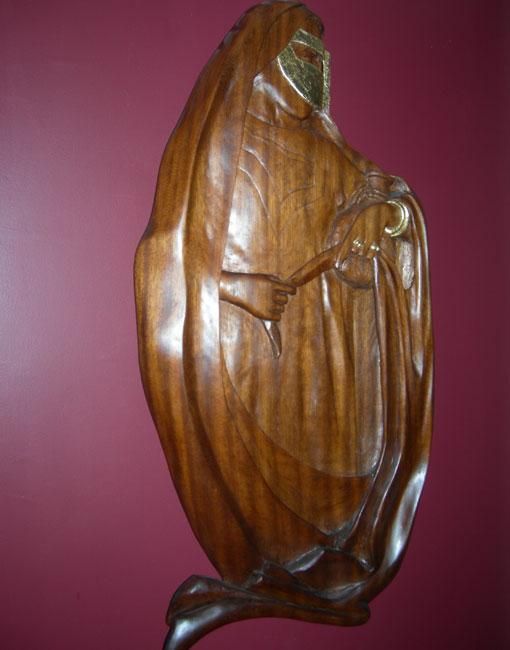Get to know Michael flook, an Abu Dhabi-based sculptor.
I think the art of sculpture – like any art – is something you're born with. I have always been aware of form and shape. All my life I have enjoyed touching things to feel their texture:
the bark of a tree, the hand-wrought stone of an ancient shrine, wet smooth marble...
I was born in England but moved along with my parents to Southern Ontario in Canada when I was 15. I'm the youngest of six children. My parents were hard-working people and their lives were greatly influenced by the Second World War.
They met at a bus stop just before the war
broke out. By the end of the war they were married. My dad worked in a paperboard mill and my mum was
a homemaker.I have two children, Richard and Victoria, from a previous marriage. Richard has a creative bent of mind.
I am living with my second wife, Brigid, who is the vice-principal of an international school in Abu Dhabi.
As a child, I started making things out of cardboard that my father brought home from work. I made a toy city to drive my dinky cars around, a suit of armour out of cardboard... As I got older the need to be creative developed and I began experimenting with a number of different materials.
Over the years I've learned to weld, to cut stone
with power and hand tools, to carve wood with chisels and axes and to shape clay and transfer that shape
into plaster, cement, wax or bronze. I took art as a subject at school and was always considered one of the best. I love visiting museums and art galleries.
I became a full-time sculptor when I moved to the UAE after Brigid accepted a teaching job here. This left me in the position of being a man of leisure. In Canada I renovated houses and worked in a factory.
Neither of these jobs was a viable option for me here.
So I turned to my lifelong pursuit of sculpting as a career. I picked up a few commissions along the way and I'm still here. It's difficult to say what medium of sculpture
I like working in. Mediums and materials convey different things. I think wood is good for faces. It is alive in a way
that other materials are not. Bronze is also good for faces and bodies.
It does not possess the same life force that I believe wood has but it has a depth to it if treated correctly. Each medium has its joys and its drawbacks. No material should be ignored.
I've been asked many times what people think about my work. This is a hard question for me to answer. To be frank, people don't think that much about sculpture. Almost everybody – every home, office or hotel room has a picture of some kind: photographs, prints and paintings. But very few have sculptures.
Sometimes when people who like art come to see my pieces, it's as though they are seeing something for the first time. The three-dimensional aspect of sculpture is often overlooked. I love to inspect a piece from every angle. Dimensions fascinate me.
People are sometimes scared by my dark pieces and wonder what is going on in my mind when I create them. Only some of my work is dark. I have a series of garden sculptures that are whimsy.
Having said that, being of an artistic temperament, I do have days when I feel cursed with the 'black dog', which is how Winston Churchill described his melancholic depressions.
The most difficult sculpture that I have done was a bust of a philosopher named Chinmayananda.
For this commission, the client wanted me to capture the spirit of the person. This I found very difficult as I'd never met the man (he had passed away some time ago). It is possible to relay the spirit of a person [through one's work], but one really has to know that person.
I have had some funny – albeit painful – experiences with sculpture. I view many things as sculptures.
When I remodel someone's bathroom or kitchen I like to approach it as I would a sculpture. On one occasion
I was using a power screwdriver to screw two pieces of wood together. I got the screw in at the wrong angle so I reversed the driver to unscrew it. But the switch didn't go all the way over.
I pressed really hard and screwed my thumb to the wood. I had to unscrew the screw to get it off. That was funny – but only after the pain had gone. I still have a bump on my thumb.
Another instance was when I rendered a bird sculpture in bronze for the Shangri-La Hotel in Abu Dhabi. The piece went through several phases before it was finished.
One of those phases was the sculpture in clay. I had the clay bird on my bench in my studio covered with damp cloth and plastic to keep the moisture in overnight. The next day I went to my studio to inspect the moisture level of the piece and was shocked. The 'bird' had been ravaged and bitten. There were deep claw marks all over its body.
I knew the culprits: the three cats that we had. Anyway I was planning to change the design of the bird, so I found the incident amusing.
I have three suspects only one of whom does not have a credible alibi.
Financially, sculpture is not a moneymaker.
If you look at history, very few sculptors have become rich or famous in their lifetime. Many of the most well-known and beautifully executed examples of sculpture are anonymous – such as the golden mask of Tutankhamun and the peaceful
face of Jayavarman VII at Angkor.
The Raha International School of Sculpture and the bird for the Shangri-La Hotel in Abu Dhabi are the latest feathers in my cap. I attended the launch of Raha International School with my wife. The school logo was displayed everywhere.
I had this inspirational flash of the logo in a three-dimensional form. I approached the heads of the school with an idea for a sculpture for the main piazza. In Canada, many schools and universities have statues of some sort and they are considered a source of school pride. The principals took the idea to the company's CEO who approved it.
I was given space – the hardest thing for a sculptor to find – at the school in which to produce the sculpture. It consists of seven tons of concrete and steel and stands 2.3 metres tall.
I made it by myself with the aid of a crane and a ladder.
The best thing about the Raha statue for me is to see the children playing around it. At break time, it takes the form of the local fort as kids sit inside and eat their food or chase each other through it. My advice to those who want to become sculptors? Just do it. Get a book if you feel you need to.
Research via the internet – there are some good tutorials online. Start with some clay and play – make shapes, make a mess and then start again. Have fun and don't force it. Read a book about it, ignore most of it and do your own thing and as you go along, you will find that they may be right about some things.
Michael Flook can be contacted on michaelflook442@hotmail.com.
– As told to Preethi Janice D'Sa, a Dubai-based freelancer
caption:














